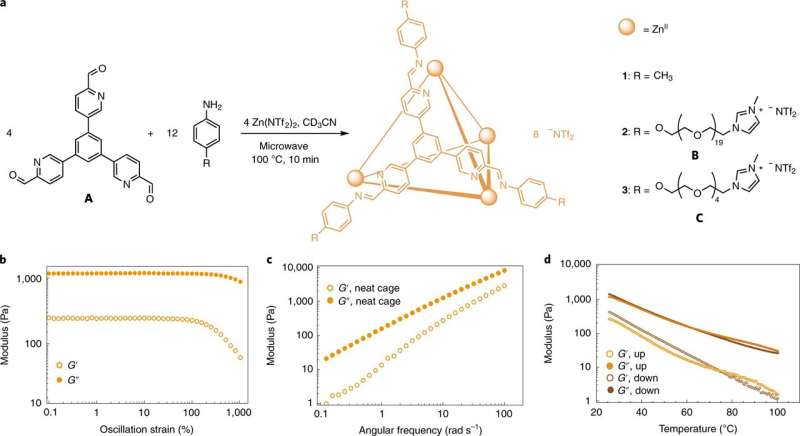February 24, 2020 report
Porous liquid holds bigger molecules

An international team of chemists has developed a method for creating an ionic-liquid, porous, tetrahedral coordination cage that holds larger molecules than other porous liquids. In their paper published in the journal Nature Chemistry, the group describes their technique and the types of molecules their liquids were able to hold.
Materials with holes, pits or pores are described as porous. In many instances, the pores in such materials are filled with air, but chemists have found ways to fill them with other useful materials, as well. In the past several years, chemists have found that liquids can also be porous—these are liquid in the traditional sense, but have large numbers of microscopic cavities. Prior research has shown that cavities can be made in porous liquids that are approximately the same size as small molecules such as carbon dioxide or methane—and such molecules can occupy the pores to create useful porous liquid products. In this new effort, the researchers have improved upon the development of porous liquids by creating cage-shaped pores that can hold larger guest molecules.
The work by the team involved the creation of very small hollow tetrahedral cages with individual zinc ions forming the corners points. They grafted three fluidifying oligo chains onto each of the ion corners and then capped them with an imidazolium group member. Using positively charged corners allowed the team to prevent long chains from entering the pores due to electrostatic forces.
The researchers tested their porous liquid by binding different guests into the cages, noting that both size and shape had an impact on which types of molecules could fit. Smaller molecules could fit neatly inside, while some larger ones could have centers based in the cage with chains reaching out past its boundaries. They also note that the cages could serve as both gas and solid guests. In their tests, they used three gaseous chlorofluorocarbons: dichlorodifluoromethane, chlorotrifluoromethane and trichlorofluoromethane.
The researchers note that the cages they created could be changed to create larger cages or cages in different shapes to suit the needs of particular guest molecules.
More information: Lillian Ma et al. Coordination cages as permanently porous ionic liquids, Nature Chemistry (2020). DOI: 10.1038/s41557-020-0419-2
Journal information: Nature Chemistry
© 2020 Science X Network




















